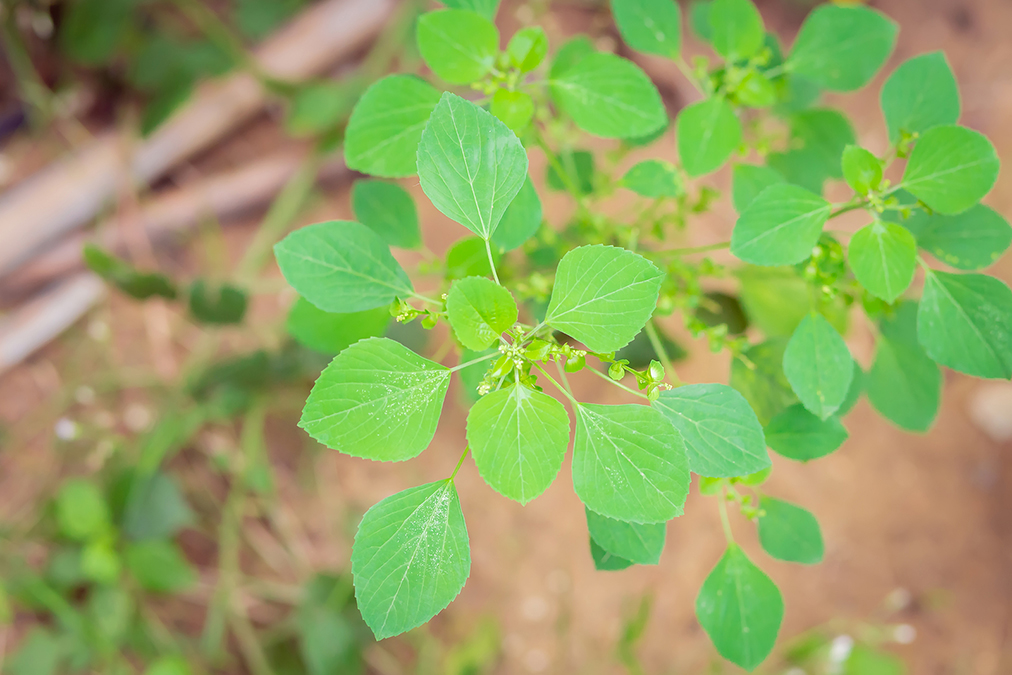 In a new study, this leaf was proven to be just as effective as leading gout drugs, but without any side effects.
In a new study, this leaf was proven to be just as effective as leading gout drugs, but without any side effects.
What’s more, if you’re lucky enough, this leaf may grow wild near you. If not, you can get extracts with the same benefits at your local health food store.
This study was presented in the Proceedings of the 4th International Conference on Sustainable Innovation 2020: Health Science and Nursing.
Very few people have heard of a plant called Acalypha indica L., even if I use its better-known name: anting-anting.
Some people also call it Indian Copperleaf, Indian Mercury, or Indian Nettle.
It occurs naturally in tropical locations like Indian Ocean islands, West Africa, North Africa, and even in India, Southeast Asia, and Oceania. It doesn’t even have to be farmed, and it grows absolutely anywhere with disturbed soil.
It is especially rich in flavonoids, which drew the attention of the researchers responsible for this new study.
In particular, it contains plenty of quercetin and kaempferol, two flavonoids that the team noted have been linked to a reduction in uric acid.
Since uric acid is responsible for causing gout, they thought that anting-anting leaf could be a good candidate as a gout treatment.
To explore this question, they obtained an ethanol extract of anting-anting leaf and enrolled 25 rats in their study.
They divided the rats into five groups:
- 1. A group that was not given any medication.
2. A group that received allopurinol, one of the most common drugs that doctors prescribe for gout.
3. A group that received 3.15 grams of extract per kilogram of body weight (g/kgBW).
4. A group that received 6.3 g/kgBW of extract.
5. A group that received 12.6 g/kgBW of extract.
The researchers first measured the uric acid levels in all the rats, after which they induced high uric acid levels in all 25 rats by injecting them with caffeine.
They then measured the rats’ uric acid again. They administered the treatments for nine days, during which they kept on measuring the rats’ uric acid levels.
They performed the last uric acid measurements more than a week after the treatments ended.
Based on all this information, they determined that both the 3.15 and the 6.3 g/kgBW doses of anting-anting extract worked to lower uric acid—but the star of the show was the 12.6 g/kgBW dose that was given to group 5.
This amount of anting-anting worked just as well as the allopurinol that was given to group 2. This drug is usually given to people with gout.
The only problem that now remains is that this extract is not commercially available. If future studies confirm these findings on human subjects, it might become available.
Until then, you will have to settle for quercetin and kaempferol, the two flavonoids that are probably responsible for most of the effect.
You can find quercetin in commercially available capsules and in green tea, red wine, onions, apples, and berries.
Kaempferol is abundant in kale, spinach, broccoli, beans, and tea.
But an even simpler way to completely reverse gout is to follow the few little steps explained here…

 Overcoming IBD
Overcoming IBD Multiple Sclerosis
Multiple Sclerosis Banishing Bronchitis
Banishing Bronchitis Gum Disease Gone
Gum Disease Gone Overcoming Onychomycosis
Overcoming Onychomycosis Neuropathy No More
Neuropathy No More The Prostate Protocol
The Prostate Protocol Brain Booster
Brain Booster
 Ironbound
Ironbound
 Solution for Shingles
Solution for Shingles
 The Bone Density Solution
The Bone Density Solution
 The Ultimate Healing Protocol
The Ultimate Healing Protocol
 The Parkinson's Protocol
The Parkinson's Protocol
 The Chronic Kidney Disease Solution
The Chronic Kidney Disease Solution
 Overthrowing Anxiety
Overthrowing Anxiety The Fatty Liver Solution
The Fatty Liver Solution The Hypothyroidism Solution
The Hypothyroidism Solution
 The End of Gout
The End of Gout The Blood Pressure Program
The Blood Pressure Program
 The Oxigized Cholesterol Strategy
The Oxigized Cholesterol Strategy
 Stop Snoring And Sleep Apnea Program
Stop Snoring And Sleep Apnea Program
 The Arthritis Strategy
The Arthritis Strategy The Vertigo & Dizziness Program
The Vertigo & Dizziness Program The 3-Step Diabetes Strategy
The 3-Step Diabetes Strategy Hemorrhoids Healing Protocol
Hemorrhoids Healing Protocol The Erectile Dysfunction Master
The Erectile Dysfunction Master Weight Loss Breeze
Weight Loss Breeze The IBS Program
The IBS Program The Insomnia Program
The Insomnia Program The Migraine and Headache Program
The Migraine and Headache Program The Neck Pain Solution
The Neck Pain Solution The Menopause Solution
The Menopause Solution The Ejaculation Master
The Ejaculation Master The TMJ Solution
The TMJ Solution The Acid Reflux Solution
The Acid Reflux Solution The Fibromyalgia Solution
The Fibromyalgia Solution The Psoriasis Strategy
The Psoriasis Strategy